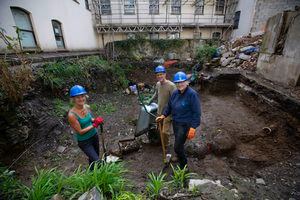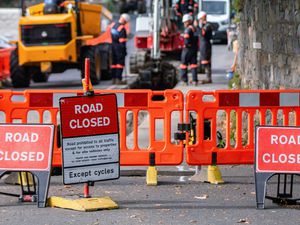Guernsey’s Time Team seek to solve Town cairn mystery
A MYSTERIOUS cairn in the heart of St Peter Port is being uncovered and examined this month, in a bid to find out more about Guernsey’s prehistoric past.

Two derelict houses in the Lower Canichers, next to the Swan pub, were finally demolished in the summer and work will start soon to create a car park.
But before that can happen, the States of Guernsey archaeology team has a month to uncover the site’s secrets.
The house gardens were dug about 15 years ago and turned up some pottery and a cairn.
States archaeologist Dr Phil de Jersey said there was more to find and this was a great opportunity to look. He was particularly interested in the cairn – a pile of stones.
‘We never really understood what it was,’ he said.
‘We need to dig a section to get a better idea. One of the things that has always puzzled me is that when you look at it from above there appear to be lines, which look like walls. We wonder if it was something later, like a Roman wall, but it may be prehistoric.’
The team are focusing their efforts on the northern side of the former gardens. The site is hemmed in on three sides by tall office buildings and the gardens themselves are about four metres below ground level.
This area would have been outside the medieval town boundary, but St Peter Port has long been a working harbour.
Dr de Jersey said it was an important area to investigate.
‘There are very few gardens left in this part of Town,’ he said.
‘We are also close to the Plaiderie – about 50 metres away – which is a Roman site.’
Roman pottery has been found on the site before and more has also been found at the nearby former Royal Hotel site.
Dr de Jersey said while the previous team had spent two years exploring the site, it had been largely done by volunteers, often working at weekends, and they had focused on the southern end. The latest dig will focus on the northern end.
‘What we need now is a shorter, more intensive excavation,’ he said.
‘The previous team found a cairn and that’s what we are getting back to. We don’t really know what its purpose was.
‘The cairn is just a pile of stones, but it could be a burial cairn. What I want is to find some evidence of what this heap of stones is.
‘It would be a bit overly optimistic to find a burial, because of the acidity of our soil.’
So far the team has stripped back the top level of soil and found a lot of glass bottles, although none are very old.
But Dr de Jersey is hopeful of finding answers over the four weeks of the dig.





